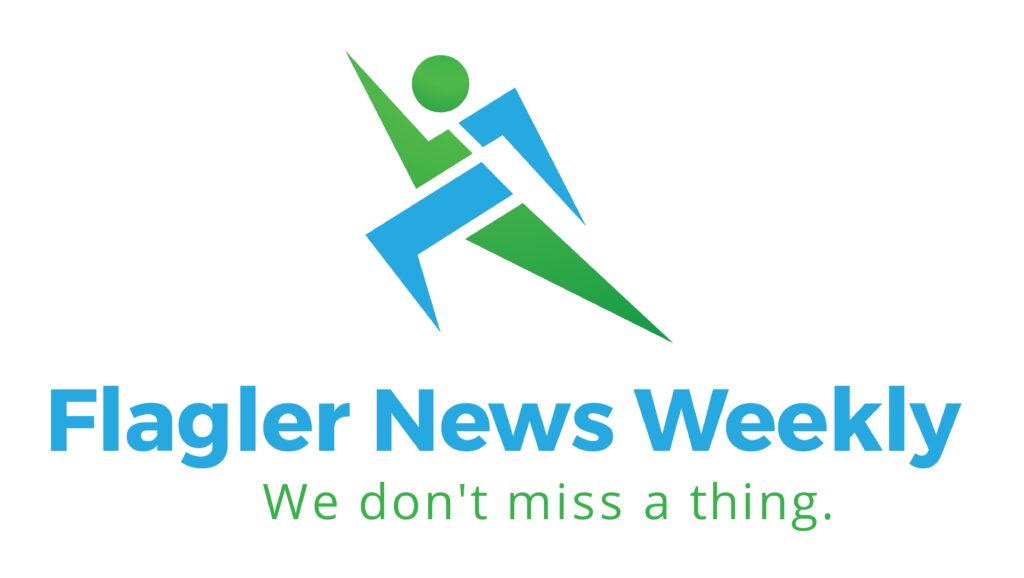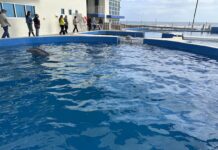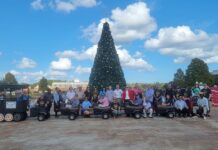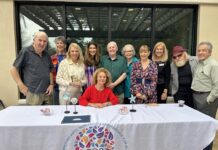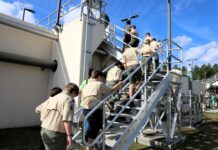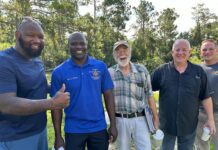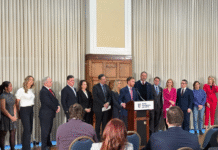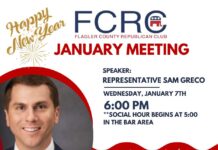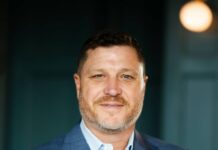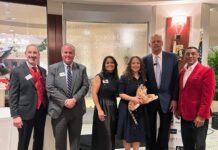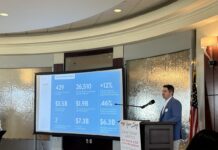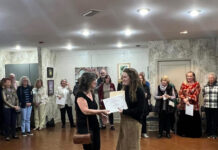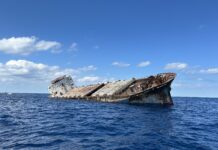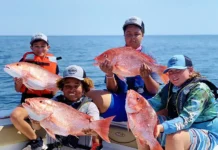It started with a conversation with Palm Coast resident Mariah George, a mother working to better understand SPATA, and the ultra-rare genetic disorder SPATA5L1 Related Disorder, her son Luca had been diagnosed with. As one of 60 in the world with his disorder, Mariah came on the radio show & podcast Lifeline to share her story and talk about The SPATA Foundation she and her husband Nicholas had launched to help families like hers.
She then mentioned another local family grappling with their child’s rare disorder and connected us to Palm Coast residents Christin, an ultrasound tech and Jericho, a machine shop supervisor, the parents of four-year-old Veda.
Today, the last day of February is Rare Disease Day and Veda’s parents are launching the campaign to save not only their daughter but others who are suffering from the Sanfilippo Syndrome. Please take a moment to watch the video. It explains it more poignantly than written words ever could.
It’s a lot of money they’re trying to raise. It’s true. So where does it all go?
“Once the donation needs are met, a team of physicians will be the ones who choose the children that will be involved in the drug trial. So without the donations, Veda has zero chance of getting into a trial,” shared Christin. “We are hopeful that she is chosen, but our fight is for Veda as well as other children with Sanfilippo Syndrome.”

Gathering more information, Glenn O’Neill, Dad, Donor, President & Co-Founder of the Cure Sanfilippo Foundation shared what’s happening on the research and advocacy frontlines in the search for a cure.
1. How can the community help?
The community can help this Saving Veda campaign by sharing SavingVeda.com with anyone and everyone they know, on social media, on email, in person. The goal is to raise the dollars to help fund a clinical trial for children, and the more people that see this video and story, the more that will have the opportunity to contribute anything they are able. Amazing things can happen when a cause like this gets momentum behind it, and a community rallies around a family. We’ve seen it happen before.
2. If this is caused by a lack of an enzyme, is there a test to determine which subtype a child has? If yes, is there a synthetic replacement available to stop or reverse the damage done?
Yes, as you probably are aware, there are 4 subtypes of Sanfilippo (A, B, C, D). It is estimated that Type A and B make up most of all diagnoses, with C being more rare, and D being very rare. Types A and B both usually progress in a more rapid way than Type C and D, with Type A often being referred to as the most rapid. Veda has Type A.
Tests can determine which subtype of Sanfilippo a child has and hence which enzyme deficiency they have. Genetic testing or testing to determine enzyme activity levels are used for diagnosis.
Research studies and clinical trials often are specific to the Type of Sanfilippo and the specific enzyme deficiency. Two of the most promising paths of potential therapies are gene therapy (a one-time dosing to replace the gene), and enzyme replacement (an ongoing every-week or every-two-week infusion boosting up the enzyme activity for a period before the need to redose). Both of these strategies aim to reduce the toxic buildup of heparan sulfate in children’s bodies and brains. This Saving Veda effort is going toward helping fund a new gene therapy approach for Sanfilippo.
3. How is the pharmaceutical industry working with organizations like the Cure Sanfilippo Foundation to support parents and provide access to clinical trials?
We work daily with pharmaceutical companies. Over the past 10 years, the pharmaceutical industry has really embraced the patient advocacy work of Cure Sanfilippo Foundation and have come to realize that they can design better clinical trials when engaging closely with the patient community early in the process. We have shared and educated them (as well as the FDA) on things like Caregiver preferences regarding treatment goals and risk/benefit tradeoffs when evaluating a potential therapy. Cure Sanfilippo Foundation conducted the first formal study of caregiver preferences in the field, engaging over 150 parents from around the world. The two scientific publications arising from this study have been cited numerous times by the FDA and biotech companies as informing their efforts.
Possibly too in depth for this story, but one of the current challenges in the Sanfilippo space for both pharma and patient advocacy groups, all affecting parents and children, is the difficult path to an FDA approved treatment, for a disease like Sanfilippo. This is SO TIMELY right now, and without going into all the background, a very important public workshop was held on Feb 21st, convening pharma, patient advocacy and FDA in Washington, DC. Cure Sanfilippo’s Chief Science Officer, Dr. Cara O’Neill, shared closing remarks at this workshop. We hope the information shared at this workshop will be a tipping point to begin allowing the “Accelerated approval” pathway for promising Sanfilippo (MPS III) therapies. Link to workshop is here: https://reaganudall.org/
But Cure Sanfilippo doesn’t just wait for pharma or FDA to create opportunities. We can’t. Too many pharma companies have abandoned their drug development mid-stream over the past decade and we still have no approved treatments. There are too many children in need, and the very few clinical trials there are (2 currently) have already fully enrolled and usually have 10 spots or less. There are hundreds of children in need in the US that we know of, and likely many thousands around the world. And for each, the clock is ticking because of the rapid damage this disease causes, where in just a few years, a child can lose so much (as the Saving Veda video shows, unfortunately).
We have to create more opportunities for children in urgent need to access treatments that do not depend solely on the companies. This means creating more clinical trials.

4. Are parents required to pay to be part of a clinical trial?
No. In a properly run clinical trial, no parent should have to pay any costs for participation. Cure Sanfilippo funded a ‘drug-repurposing’ clinical trial study a few years ago enrolling 24 children. Costs for travel, lodging and food are provided as part of the study. Parents are not burdened by those costs. The Saving Veda dollars raised would help fund the clinical trial costs for this new gene therapy study, for whatever children are chosen. What we know, at this time, is that if we don’t raise the funds for this, there is no safety net, this clinical trial simply won’t happen.
5. Are there any successful therapies available to parents/caregivers of any subgroup of the disorder?
By subgroup of this disorder I’m not sure if you are referring to the other some-what related MPS disorders, or the Types of Sanfilippo, so I’ll answer for both. There are no FDA approved treatments of any form (Type) of Sanfilippo syndrome (MPS III). For other MPS disorders like MPS 1 (Hurler) and MPS II (Hunter), and others they do have FDA approved enzyme replacement therapies.
6. You have a call for proposals due Q1 2024. Have any LOI been submitted?
We are actually working to begin our next call for proposal and you’ll see it says that we expect to launch this call for proposals in 1st quarter, so the proposals aren’t due back by then, we just plan to launch another round. Outside of our call for proposals, Dr. O’Neill is working with scientists and researchers daily on creating new ideas for new therapeutic approaches for Sanfilippo, so often we are working though possible research opportunities outside of our official “grant round”. We are currently working with previously funded scientists on expanding several promising areas of research that they have already laid the groundwork for in a previous funding cycle. We fund not only very early-stage research on new promising ideas, but also more advanced research moving closer to clinical trials. We’ve also funded actual drug production for clinical trials, clinical trial staff needs, and as mentioned above, the actual clinical trial costs. Our decisions on what to fund are made by our Board of Directors after reviewing the feedback from our CSO and Scientific Advisors and external independent reviewers. These are always difficult decisions because the funds are limited.
7. On Rare Disease Day 2024, what words of hope can you offer parents?
As a parent myself of a little girl (Eliza) diagnosed with Sanfilippo at age 3, and who is now 14, we understand the deep pain and loss that this disease brings. We send all the strength in the world to the parents, siblings and extended family going through this difficult journey. Rare disease research never seems to move fast enough against a disease like Sanfilippo. But we are at a moment in time, where new opportunities could be coming, both with helping fund this new gene therapy clinical trial, another ‘drug repurposing’ trial we are working on, and with the hopeful FDA flexibility to allow potential treatments a path forward to approval and access for many more children. I’m inspired by the so-many families who have jumped in this fight and they and their supporters are ones to thank for the progress in Sanfilippo research over the past 10 years. Families like Veda’s (Ulrich’s), and Haidyn’s (Fowler’s) from the video, who share their stories with the world. As my wife Dr. O’Neill said about Hope…”Hope is just love…on a mission”.

